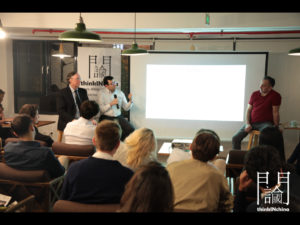

SPEAKERS
Juan COLE, Richard P.Mitchell Collegiate Professor of History, University of Michigan
Mohsen SHARIATINIA, Assistant Professor, Shahdid Beheshti National University of Iran
Tugrul KESKIN, Professor and Director, Center for Global Governance, Institute of Global Studies, Shanghai University
VIDEO INTERVIEW (on YouTube)
REPORT
American foreign policy in the Middle East has gone through a process of transformation, starting from its first engagement at the beginning of the XX century with President Truman, when the United States was a relatively young global power trying to contain the communist threat, to the new liens of the current administration. According to Tugrul Keskin, Professor and Director of the Centre of Global Governance at Shanghai University’s Institute of Global Studies, with the decolonization process and the reshaping of territory, and after the Islamic Revolution of 1979, Washington’s attention has shifted to their strategic alliances with ethnic and religious groups, “pro-democracy” movements and “civil society” organizations in the Middle East.
The Gulf War between 1990 and 1991 accelerated the US grand strategic plan for the region, based on collaborations with local ethnic, religious, and opposition groups, as well as with NGOs and media organizations. However, the terrorist attacks of 2001 resulted in another change of direction in US foreign policy, which has since started focusing on the Greater Middle East Initiative for regime change in the region, which is directly in line with democracy promotion agenda with Reagan administration.
Analyzing Washington’s current agenda and several steps it has taken in this area, Professor Keskin highlights how the present administration has shifted its position after appointing key figures in the government cabinet. With Mr. McMaster as the main strategic guide of US foreign policy, it is evident that President Trump has moved towards more established policies when addressing issues in the Middle East, compared to the more assertive and uncertain approach taken in his first years in power.
A further analysis of Washington’s political élite, both Democratic and Republic, and their perspective on the President’s approach to the Middle East over the last two years, emphasizes that Trump should assess his stance in order to avoid being marginalized for his detached-from-the-status-quo” policies and actions in both domestic and foreign strategies, especially in view of next year’s presidential elections.
According to Professor Juan Cole of the University of Michigan, what typifies Trump’s foreign policy in the Middle East, as well as the rest of his policies, is that they have proved divisive within his own administration. Although Trump increasingly favors the disentanglement of the United States from its previous commitments and tends to let other countries in the Middle East rely on their own resources for assistance, he is surrounded by a strongly globalist component, represented by the American national security establishment, which firmly believes in the role of NATO and the United States’ role as a security provider in the region.
As Professor Cole observes, almost no one around Trump agrees with his policies, whether it’s the abolition of the Iran nuclear deal, his trade war with China, or, more generally, his policy of Offshore balancing. Following the defeat of ISIL in Iraq and Syria, Trump proposed the withdrawal of American troops, while the rest of Washington sustained that, as long as the terrorist organization remains a threat, withdrawing troops would not be a suitable alternative.
These are among many examples of a divided administration, despite their attempts to reach a compromise with the President and secure a much needed resolution on these issues. Disagreements between Trump and his cabinet continue to play a major role in US foreign policy in the Middle East, and Trump’s being vocal about his own personal opinions on Twitter has only further complicated the situation.
But what is China’s role in this complex and unsettled scenario?
Assistant Professor Mohsen Shariatinia of the National University of Iran (Shahdid Beheshti) attests that there are two main forces that drive China-Middle East relations. The first is the complex interdependent structure of the relationship itself; Middle Eastern countries base their economic security on the oil market and mostly depend on Chinese imports. In addition, on international security issues, China and Middle Eastern countries are becoming more and more interdependent. The national security of both sides is increasingly dependent on sea lines of communication.
The second factor worthy of consideration is the important role Middle Eastern countries play in the Belt and Road Initiative’s broader agenda. By connecting China and Europe, this region has always been a crucial geo-strategic centre and remains of fundamental importance in the execution of China’s BRI. Nevertheless, implications are not lacking and should not be underestimated, as neither the role that the United States plays in this setup. Washington is putting pressure on some countries in the region to stop cooperating with China and, as in the case of sanctions against Iran, is taking actions that hamper the involvement of key countries in the BRI.
As for the possibility that China could take over as a security provider in the region? Shariatinia’s assessment is that as a result of a wide network of long-established alliances in the region and its interests in Israel, the United States will continue to hold the dominant role in the Middle East. As long as the US maintains this position, China will keep choosing to cooperate rather than deciding to step in as an alternative security provider, for the simple reason that the Middle East does not belong among Beijing’s core interests.
Report written by Chiara Cattaneo
Video interview edited by Martina Poletti